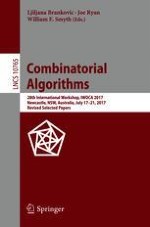2018 | OriginalPaper | Buchkapitel
Complexity Dichotomies for the Minimum \(\mathcal {F}\)-Overlay Problem
verfasst von : Nathann Cohen, Frédéric Havet, Dorian Mazauric, Ignasi Sau, Rémi Watrigant
Erschienen in: Combinatorial Algorithms
Aktivieren Sie unsere intelligente Suche, um passende Fachinhalte oder Patente zu finden.
Wählen Sie Textabschnitte aus um mit Künstlicher Intelligenz passenden Patente zu finden. powered by
Markieren Sie Textabschnitte, um KI-gestützt weitere passende Inhalte zu finden. powered by
